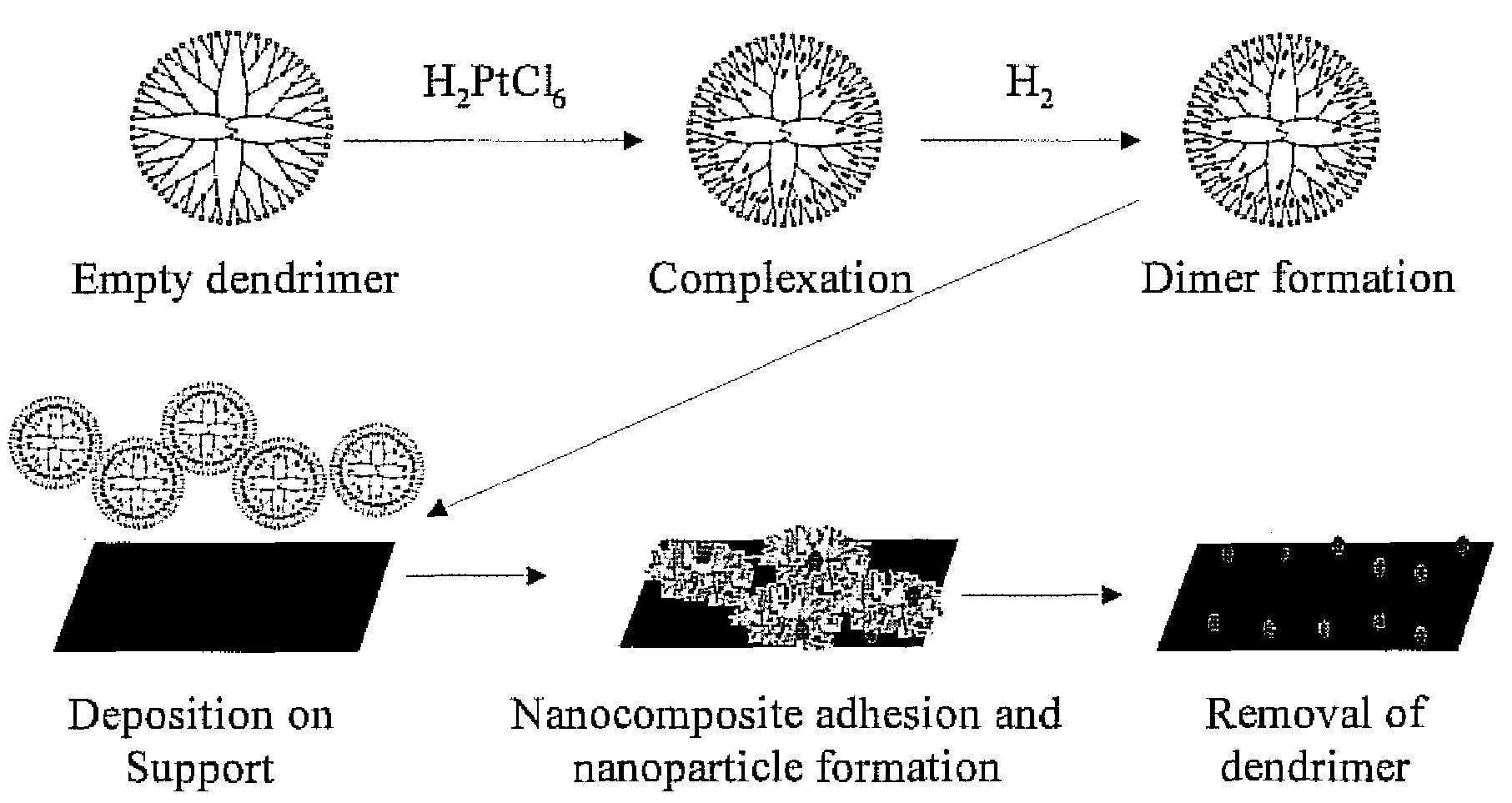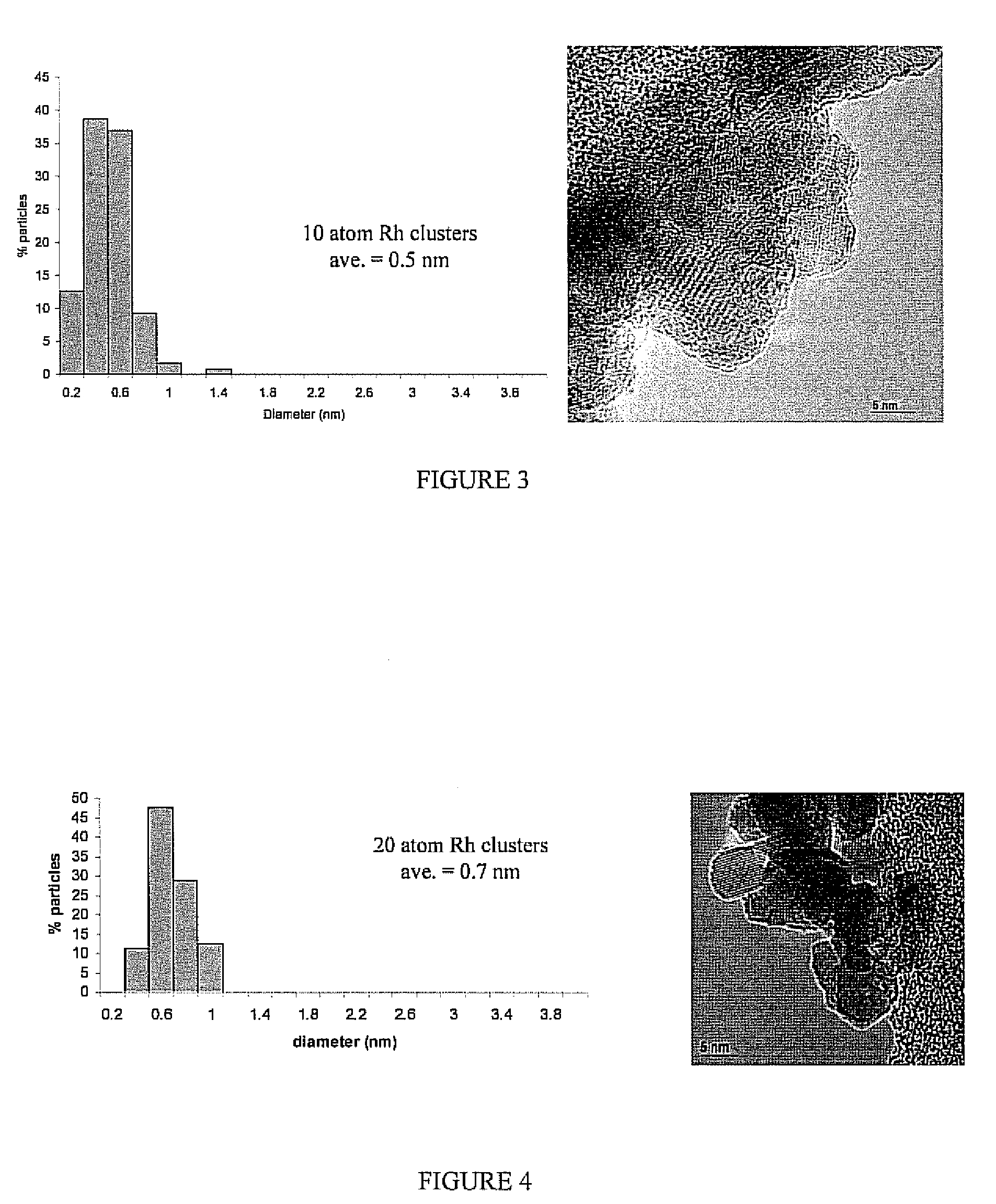Supported catalysts with controlled metal cluster size
a technology of supported catalysts and clusters, which is applied in the field of catalysts, can solve the problems of poor control over metal particle size, geometry, metal dispersion, etc., and achieve the effect of precise control of particle size, particle spacing, and particle size distribution in the catalys
- Summary
- Abstract
- Description
- Claims
- Application Information
AI Technical Summary
Benefits of technology
Problems solved by technology
Method used
Image
Examples
example 1
[0029]An appropriate amount of a 2.5×10−2 M aqueous solution of H2PtCl6.6H2O was added under nitrogen flow to a 0.17 M aqueous solution of G4OH dendrimer in order to obtain the desired molar ratio of metal to G4OH dendrimer. The mixture was stirred under nitrogen flow for 3 days to allow for the complexation of Pt cations in the solution with the functional groups of the dendrimer. The dendrimer-Pt complexes were subsequently mixed with a freshly prepared NaBH4 solution (molar ratio of BH4− to metal cation of 8 to 1) in order to better facilitate reduction of the incorporated Pt cations. Following this step, the Pt-dendrimer metal nanocomposites were deposited onto previously calcined (in air, overnight at 500° C.) γ-Al2O3 via standard wet impregnation. The solvent was allowed to evaporate by stirring the resulting slurry at ambient conditions.
example 2
[0030]This approach has been extended to the synthesis of Rh-dendrimer nanocomposites. Instead of 3 days of metal-dendrimer complexation, the Rh samples required only 1 day for incorporation within the dendrimer. Similarly, rhodium-dendrimer-metal nanocomposites were deposited onto a commercial ZrO2 support (uncalcined). The nominal metal loading of both supported metal catalysts used in this study was 1 wt %.
example 3
[0031]Pd-dendrimer nanocomposites have also been synthesized, and the process is identical to that of preparing Rh-dendrimer metal nanocomposites. Complexation of the palladium precursor, K2PdCl4, requires only 1 day for incorporation within the dendrimer. After reduction in solution with NaBH4, the resulting Pd-dendrimer nanocomposites were deposited onto calcined aluminum oxide.
[0032]In all of the examples, the dendrimer was removed as a final step in forming a catalyst. Various conditions for different metal, dendrimer and support materials may be used to remove the dendrimer. For example a sequential oxidation at an elevated temperature followed by a reduction at an elevated temperature may be used by the process. The temperature of the oxidation may range from 300° C. to 500° C. for the various support materials, with various exposure times. In one aspect, the oxidation may be at 420° C. for one hour in a 10% O2 / He atmosphere Al2O3 and ZrO2 supports and greater than 300° C. for...
PUM
| Property | Measurement | Unit |
|---|---|---|
| size | aaaaa | aaaaa |
| temperature | aaaaa | aaaaa |
| temperature | aaaaa | aaaaa |
Abstract
Description
Claims
Application Information
 Login to View More
Login to View More - R&D
- Intellectual Property
- Life Sciences
- Materials
- Tech Scout
- Unparalleled Data Quality
- Higher Quality Content
- 60% Fewer Hallucinations
Browse by: Latest US Patents, China's latest patents, Technical Efficacy Thesaurus, Application Domain, Technology Topic, Popular Technical Reports.
© 2025 PatSnap. All rights reserved.Legal|Privacy policy|Modern Slavery Act Transparency Statement|Sitemap|About US| Contact US: help@patsnap.com



